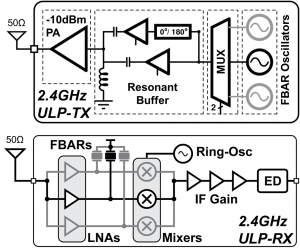A Mini-platform for Wireless Sensors
- Category: Circuits & Systems
- Tags: anantha chandrakasan, arun paidimarri, nathan ickes
Sensing, data processing, and communication are essential functions of a useful sensor node, whether used in industrial, health or sports monitoring applications. Long battery lifetimes are required for these sensors, and the small size requirements imply small energy storage/harvesting capability. Extreme energy efficiency is thus required in the system and circuit design. This project developed a mini-platform for wireless sensors that highlights the capabilities of two custom ultra-low power transmitter and receiver chips. Figure 1 shows a photograph of the completed prototype with the important modules highlighted. Accelerometer data is packetized and transmitted to a base-station, and a reverse communication link from the base-station to the low-power radio controls some features of the node. The base-station is a custom USB dongle containing a commercial transceiver (TI CC2500), demonstrating the ability of the custom ultra-low-power radios to communicate with generic and readily available hardware. On the mini-platform, an FPGA is used to manage system-level applications. A thumbwheel on the board controls the state of the system, and a Li-ion battery powers the board. The board and battery size is limited by the FPGA and not the featured custom transceiver ICs; hence, dramatic size and power improvements are possible with integration of the application logic into the same silicon as the transceivers.
Figure 2 shows the block diagrams of the transmitter and receiver chips. These have been built for short-distance applications such as Body Area Networks. High-Q FBARs are leveraged to provide front-end filters in the receiver and stable center frequencies in the transmitter with ultra-low power consumption. The high-Q resonators result in inherently single-channel operation in the 2.4GHz ISM band; however, the TX and RX architectures provide multi-channel operation by using multiple FBARs. The PA is optimized for output powers near -10dBm and provides a power-efficient amplitude pulse-shaping scheme. In the RX, the LNA filters incoming RF using the parallel resonance of the FBAR. The cascode switches multiplex channels without degrading the LNA performance. A low-power ring oscillator mixes down to the IF frequency, where envelope detection gives the OOK demodulated data. The circuits are fabricated in 65nm CMOS and operate from a 0.7V supply. The TX consumes 436pJ/bit for 1Mbps -10dBm OOK data while the RX has a sensitivity of -67dBm for 1Mbps OOK and consumes 180pJ/bit.
In the mini-platform, due to aggressive duty-cycling, low energy per bit, and low startup time, the average power consumption of the transmitter was measured to be <14µW.
- Figure 1: Photograph of the completed prototype.
- Figure 2: Block diagram of the transmitter and receiver used in the mini-platform.

